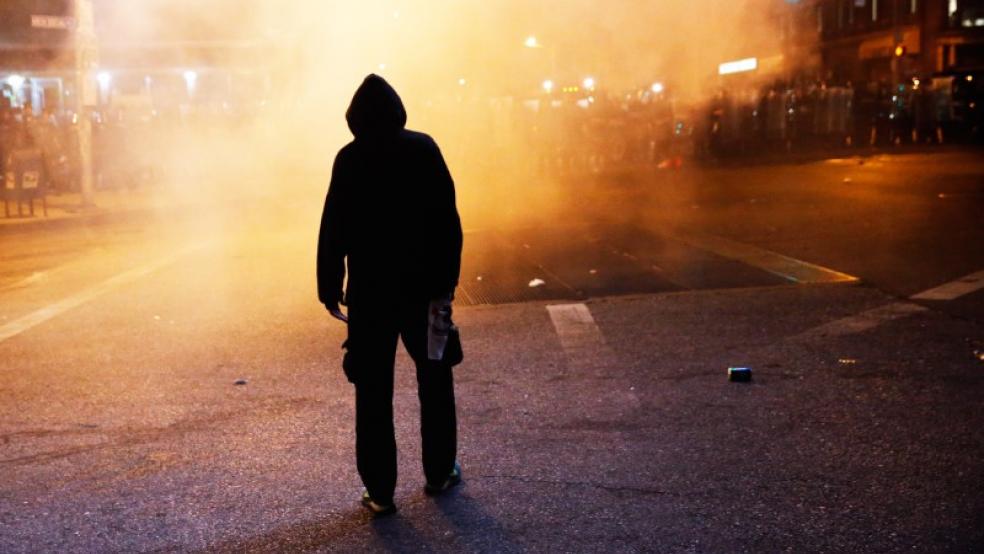TOWSON, Md. (Reuters) - As a jazz band played outside the courthouse and people enjoyed an outdoor lunch, the leafy suburb of Towson, Maryland, felt a world away on Thursday from the tension in Baltimore after a black man died of injuries sustained in police custody.
The latest outburst of racially tinged rioting to hit the United States over the past year happened on Monday night 10 miles (16 km) south of Towson in West Baltimore, where some burned-out lots from riots in 1968 still stand vacant.In Towson, retired management consultant Bob Vaughan, 77, said he had lived in Baltimore at the time of the riots that followed the assassination of civil rights leader Martin Luther King Jr.He remembered worrying that his house would be burned in the many fires. To Vaughan, Monday's violence in which 19 buildings and more than 100 vehicles were burned, did not compare to the widespread chaos seen nearly a half-century ago."People seemed to think it was like it had been in 1968 and it just wasn't," said Vaughan.He doubts the unrest will spread to Towson. "I think about it. I don't really worry about it, but I think about it.” Towson, home to the 149-year-old Towson University, and streets of neatly kept homes, shops and restaurants, is far better off economically than Baltimore.Almost one in four of Baltimore's 620,000 residents live below the poverty line, about two and a half times the state of Maryland's average of 9.8 percent. Just 27 percent have a college degree, according to U.S. Census data.In contrast, just 11 percent of Towson's roughly 55,000 people live below the poverty line, and more than 60 percent have finished college, about double the state average.SAFE HERE?The night of violence in Baltimore was triggered by the death of a 25-year-old black man, Freddie Gray, who suffered severe spinal injuries after being arrested by police on April 12. He died in hospital a week later and prosecutors are investigating.The rioting echoed anger over police killings of unarmed black men in Ferguson, Missouri, New York and other cities, and drove home the point that tensions between black communities and police can flare up at a moment's notice."It's sad that the young people think they have to do that, that they acted that way. Young minds aren’t fully formed and they need better direction," said Judy, 72, who works in the Towson courthouse and did not wish to give her full name."I feel safe here. I walk a mile to work each day, I walk home. I don’t worry," she said.While the scene in Towson was far calmer than Baltimore, Andre Hudson, 47, who is black, said he has been stopped by police on his way home from work for no reason he could discern."This keeps happening all over the country. It could happen anywhere. It could happen here," said Hudson, a retail worker, as he stood in a well-kept park outside the Baltimore County Courthouse.Having lived in Baltimore for many years before moving to Towson, Hudson said he hoped Gray's death would prompt government officials including Baltimore Mayor Stephanie Rawlings-Blake to find ways to give more opportunities to young people, which he said could help reduce crime and ease relations between police and the community."They need to understand the situations in these communities," Hudson said. "They look at someone who's dealing drugs or committing crimes, but they don't see that no one chooses to live like that. It's a lack of options."Unlike the St. Louis suburb of Ferguson, which was torn by riots last summer after a white police officer shot and killed an unarmed black man, Baltimore has many black elected leaders representing its 63 percent black population. The unrest illustrated that tensions with police run deeper than race, Vaughan said."The mayor needed to be listening to the high school students before all this happened," Vaughan said. "If a black mayor and a black police commissioner (Anthony Batts) can't get good input from the community, it makes you wonder who could."Some others appeared less concerned."It just keeps happening. I don't know that there's anything you can do about it," said Ben Andrews, a 21-year-old plumber, who is white. "I don’t see how it has a lot to do with me.” (Editing by Jill Serjeant and Grant McCool)Ten miles north, and a world away, from Baltimore's troubles

ERIC THAYER



